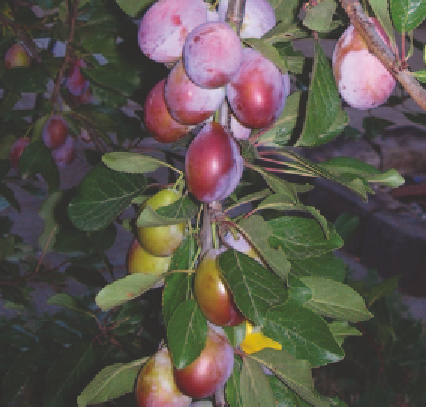Agriculture Reference
In-Depth Information
page 140). Shortening back side growths can
encourage their development.
Japaneseplums
P.salicina
Japanese plums fruit best from one-year-old
wood as well as producing short-lived spurs.
Fruiting buds arise from the previous season's
wood so fresh growth each year should be
encouraged to carry the next year's crop.
Shorten wood that has fruited after harvest
when it can be cut back to a strong side shoot
of new growth. These growths should be
thinned to prevent overcrowding. Prune back
long willowy stems by about a third otherwise
they will be prone to weather damage.
Figure 6.31
European plums can develop elegant
weeping habit, but prune to an outward- and upward-
facing bud to keep the branches clear of the ground.
Pruningtime
All plums are best pruned in summer to
minimise the incidence of disease. After
harvest is the obvious time, but vigorous
unwanted growth can be tamed or removed
before netting. Japanese plums can have their
two-year-old wood shortened by at least a
third just after harvest producing new growth
that will fruit the next year.
include greengages, prunes and general
desert plums (see Figure 6.31). The Japanese
plums are also yellow-fleshed but have a
group called blood plums with deep red flesh.
The Japanese plums are a larger tree, flower
earlier and have different pruning
requirements to the European. The
Europeans are easier to fan espalier, while
both do well trained to pyramid, spindle and
open vase forms (see page 126, 'Free-standing
fruit trees'). There are a few self-fertile plums
but most need a cross-pollinator. Check that
you have compatible cultivars.
Maintenance
Once established, both these plums need
minimal pruning. Prune to correct their
shape, remove dead, diseased crossed or
crowded growth and to renew fruiting wood.
Always keep them open to the light and air by
removing crowded growth. Often the
European plum develops a weeping habit so
that when shortening new growth or larger
branches, cut to an outward- and upward-
facing bud or side growth. This will prevent
the branches dragging on the ground. Wood
Fruitingwood
Europeanplums
P.domestica
These plums fruit on relatively long-lived
spurs that develop on two-year-old wood
much like apples and pears (see Figure 5.28,

